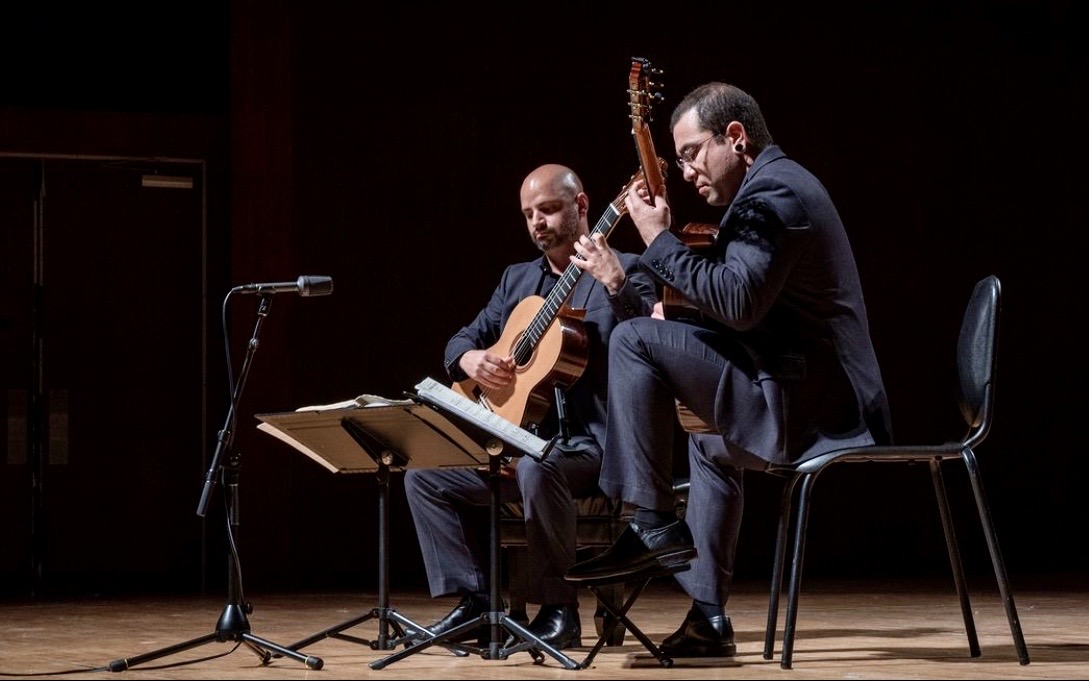Puerta-Vázquez Duo

Recorded in Spring 2025 at the Jeffrey Haskell Recording Studio, at the School of Music, University of Arizona, Tucson, Arizona. Produced by José Luis Puerta & Alfredo Vázquez. Recording and mastering Engineer: Wiley Ross.
Puerta-Vázquez Duo
The Puerta-Vázquez Duo — The Puerta-Vázquez Duo has established itself individually as educators and as promoters of guitar chamber music. Embodied by José Luis Puerta and Alfredo Vázquez, the duo was formed in 2020 after a decade of collaborating and performing together in different ensemble settings, such as guitar orchestras and quartets. Their debut album, Appunti was released in 2022 under the label Constrates Records. They are both alumni of the University of Arizona, where they studied under the legendary Sergio and Odair Assad. This mentorship profoundly shaped their artistic voice, fostering a refined sense of ensemble playing and interpretive insight. As part of their commitment to expanding the guitar duo repertoire, this album is the result of a two-year project that involved commissioning duo pieces by new composers from Latin America. The album also includes premier recordings from the late guitarist-composer Leonardo Egúrbida. The album Intercambio is named after one of his pieces as an homage. They maintain an active concert schedule across the southwestern United States and Latin America, captivating audiences with their artistry and the unique synergy of their musical partnership.
Alfredo Vázquez is an Associate Faculty at Cochise Community College, Lead Guitar Regional Director for Southern Arizona, and he is pursuing is Doctor of Music Arts degree at Arizona State University. Dr. José Luis Puerta is an Associate Professor at the School of Music, University of Arizona, and the director of the Tucson Guitar Society Orchestra.
About the new compositions:
Botanica del Viento is a cycle of songs written in the form of décima. The form of the pieces follows the Mexican tradition where flowers and death are intertwined in the same breath. Composed in 2014 with the support of Jóvenes Creadores, Fonca (National Endowment for Culture and Arts), today it is reborn as part of a new arrangement for the Puerta-Vázquez Duo as part of their project Intercambio. Días flor speaks of a brief and bright encounter between a flower and a butterfly that within itself is suspended in time. Flor de hielo portrays the fragility and loneliness of a flower born in the ice, and how it survives against the hardship of desolation and change. These are wordless songs that consider the fleeting events of beauty, flourishing against adversity and death.
NUR SLIM
Estampas Huastecas. When I was a teenager growing up in Mexico City, I had the chance to travel to the Huasteca region. As a young music student, I was part of a research team conducting interviews and surveys with indigenous populations. I spent a few months traveling, meeting people, and most importantly, listening and immersing myself in their traditional music. Musically, the Huasteca is known for its Huapango, traditionally played by a trio consisting of a jarana, quinta huapanguera (a low, guitar-like instrument), and violin. The beauty of huapango lies in its intricate strumming patterns, which create a rhythmic foundation that allows the violin to flow freely with remarkable speed and precision. Estampas Huastecas is a piece inspired by those memories of being out in the countryside, listening to this beautiful music, and being amazed by the musicianship of the local artists. When the opportunity to write a piece for the Puerta-Vázquez Duo came up, I wanted to weave the spirit of huapango—its distinctive rhythms and strums—into the piece. Working with the duo has been an incredible joy, and I couldn’t be happier with the recording. I truly hope that listeners can experience some of the magic of the Huasteca through this music.
JORGE SOSA
Carmen is a musical composition in the Puerto Rican danza genre, which was born in the mid-19th Century and was influenced by European dances and Afro-Caribbean syncopation. The danza is considered a symbol of Puerto Rican identity and cultural expression. Carmen was originally composed for the Puerto Rican national instrument, the cuatro, along with guitar and percussion. The version recorded in this album is an arrangement for two guitars. This danza is titled after the composer’s wife, to whom it is dedicated.
ALEXIS H. RIVERA-RÍOS
La leyenda de Teruel is dedicated to the Puerta-Vázquez Duo for their album Intercambio. I used the structure of the danza as the form for the piece, such as the paseo (introduction). The A section is the first merengue with a danceable and rhythmic section with syncopation. The B section, second merengue, modulates to minor with a more traditional counterpoint without losing the essence of the Puerto Rican danza. In the C section, there is a recapitulation of the main theme with variation on the rhythm and a dialogue between the guitars that resembles the 3/2 clave so commonly used in Caribbean music.
RUBÉN SANTIAGO VÁZQUEZ
Intercambio. This piece was written by the late Leonardo Egúrbida. He was the founder of the guitar program at the Conservatory of Music in Puerto Rico. The piece was originally composed for the Batista-Egúrbida Duo: Gustavo Batista (mandolin), and Leonardo Egúrbida (guitar). The duo gained international recognition in Latin America during the 20th Century. The manuscript of the piece was received by Jose Luis Puerta from Egúrbida’s wife, Vilma Maldonado. The piece has two movements, Preludio and Tocata. The first one is a playful and melancholic game that imitates the tuning of the mandolin and the guitar, and the latter one resembles a toccata in the baroque style. This transcription for two guitars was done by the Puerta-Vázquez Duo, and as an homage to the late maestro, we have named the album in his honor.
LEONARDO EGÚRBIDA
Parallel Perceptions. This piece was commissioned by, and is dedicated to, the Puerta-Vázquez Duo. The piece is written in one music staff as opposed to the traditional two staves for a guitar duo. Both players play the same part, but the uniqueness of the piece comes from preparing the guitars by adding capos at different frets to create the parallel third effect. The thirds effect creates a vertical harmony as opposed to horizontal harmonies of the romantic style. The thirds alternate between major and minor modes, creating the perception of serialism, but at the same time, avoiding dodecaphony. The piece combines asymmetrical and symmetrical rhythmic patterns with symmetrical harmonies, creating an atmosphere that is both intricate and immersive, offering the listener a fresh sonic experience.
EDWIN GUEVARA GUTIÉRREZ
Special Thanks
Thank you to everyone involved in the production of this project. Thank you to all the composers who contributed their time and artistry to make this possible: Nur Slim, Jorge Sosa, Ruben Santiago, Edwin Guevara, and Alexis Rivera. Thank you to Vilma Maldonado for making available the manuscripts for Egúrbida’s composition and for being supportive of the arrangement. Thank you to our dear friend David Pérez for the percussion. Thank you to Julia Pernet and the Tucson Guitar Society for supporting us with the production costs. Thank you to Wiley Ross for the recording of the album and to the Haskell Recording Studio at the School of Music, University of Arizona.

 Amazon
Amazon



